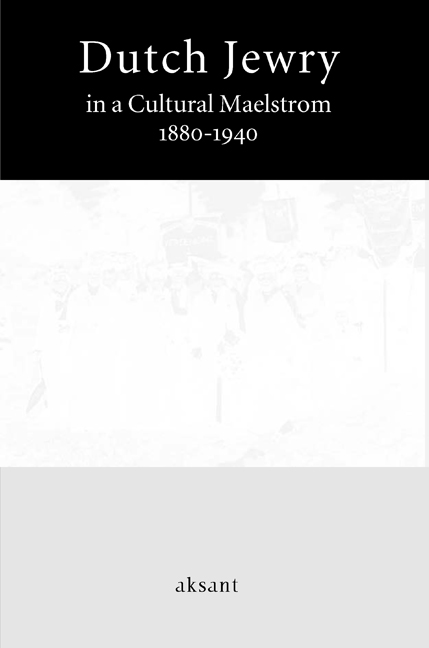Book contents
- Frontmatter
- Contents
- Foreword
- The New “Mosaik”: Jews and European Culture, 1750-1940
- The Politics of Jewish Historiography
- “The First Shall be the Last”: The Rise and Development of Modern Jewish Historiography in the Netherlands Until 1940
- Epigones and Identity: Jewish Scholarship in the Netherlands, 1850-1940
- Judaism on Display: The Origins of Amsterdam's Jewish Historical Museum
- De Vrijdagavond as a Mirror of Dutch Jewry in the Interbellum, 1924-1932
- “Holland is a Country which Provokes Serious Reflection…”: Images of Dutch Jewry in the German Jewish Press
- Spinozism and Dutch Jewry between 1880 and 1940
- Spinoza's Popularity in Perspective: A Dutch-German Comparison
- Mozes Salomon Polak: Jewish “Lerner” and Propagator of Freemasonry, Spiritualism, and Theosophy
- Jewish Women, Philanthropy, and Modernization: The Changing Roles of Jewish Women in Modern Europe, 1850-1939
- Roosje Vos, Sani Prijes, Alida de Jong, and the others: Jewish Women Workers and the Labor Movement as a Vehicle on the Road to Modernity
- Stemming the Current: Dutch Jewish Women and the First Feminist Movement
- Dutch Jewish Women: Integration and Modernity
- Index of Names of Persons
- Index of Subjects
“The First Shall be the Last”: The Rise and Development of Modern Jewish Historiography in the Netherlands Until 1940
Published online by Cambridge University Press: 26 January 2021
- Frontmatter
- Contents
- Foreword
- The New “Mosaik”: Jews and European Culture, 1750-1940
- The Politics of Jewish Historiography
- “The First Shall be the Last”: The Rise and Development of Modern Jewish Historiography in the Netherlands Until 1940
- Epigones and Identity: Jewish Scholarship in the Netherlands, 1850-1940
- Judaism on Display: The Origins of Amsterdam's Jewish Historical Museum
- De Vrijdagavond as a Mirror of Dutch Jewry in the Interbellum, 1924-1932
- “Holland is a Country which Provokes Serious Reflection…”: Images of Dutch Jewry in the German Jewish Press
- Spinozism and Dutch Jewry between 1880 and 1940
- Spinoza's Popularity in Perspective: A Dutch-German Comparison
- Mozes Salomon Polak: Jewish “Lerner” and Propagator of Freemasonry, Spiritualism, and Theosophy
- Jewish Women, Philanthropy, and Modernization: The Changing Roles of Jewish Women in Modern Europe, 1850-1939
- Roosje Vos, Sani Prijes, Alida de Jong, and the others: Jewish Women Workers and the Labor Movement as a Vehicle on the Road to Modernity
- Stemming the Current: Dutch Jewish Women and the First Feminist Movement
- Dutch Jewish Women: Integration and Modernity
- Index of Names of Persons
- Index of Subjects
Summary
The unilateral view of Jewish history in post-biblical Judaism formed a serious deterrent for the development of Jewish historiography. The rabbinical precepts for diaspora life had grown into a rigid structure aimed at religious, political, and cultural survival of the Jewish people in its dispersion, and remained valid until the end of the eighteenth century. The idea behind the rabbinic strategy of survival was that the people of Israel had lost its national homeland because of its sins. Israel, therefore, had to wait in the golah until the coming of the Messiah in God's own time, when the redemption would take place. The remnants of the righteous would then be assembled in the Land of the Forefathers, to rule mankind in God's everlasting peace.
The Jewish code of behavior in the waiting-room of history was equally rigid. The Jews had to submit to their non-Jewish rulers, however harsh that rule might be: armed resistance was strictly forbidden. When circumstances became too unfavorable, the only solution was to flee to safer places. The Ha-noten prayer for the welfare of the non-Jewish ruler, which was recited in all synagogues of the diaspora – whether the ruler be good or bad for the Jews – was the religious expression of the rabbinical code of behavior. The halakhic (legal) basis for the relationship between the Jewish communities and the local rulers was the doctrine of dina demalkhuta dina (the law of the kingdom is the law), which acknowledged the validity of the laws of the lands insofar as they did not impinge on the laws of the Jewish religion. What happened locally and incidentally to Jewish communities was not of general interest, and was only locally remembered. Only when disasters occurred which caused great and lasting hardships, like the expulsion of the Jews from Spain in 1492 and the ravaging pogroms in the Ukraine in 1648, did the Jews in the rest of the diaspora show their interest and concern. There were a few individual endeavors to introduce a wider view of Jewish history in the sixteenth century, but that did not change the general outlook.
- Type
- Chapter
- Information
- Dutch Jewry in a Cultural Maelstrom1880-1940, pp. 43 - 52Publisher: Amsterdam University PressPrint publication year: 2008



